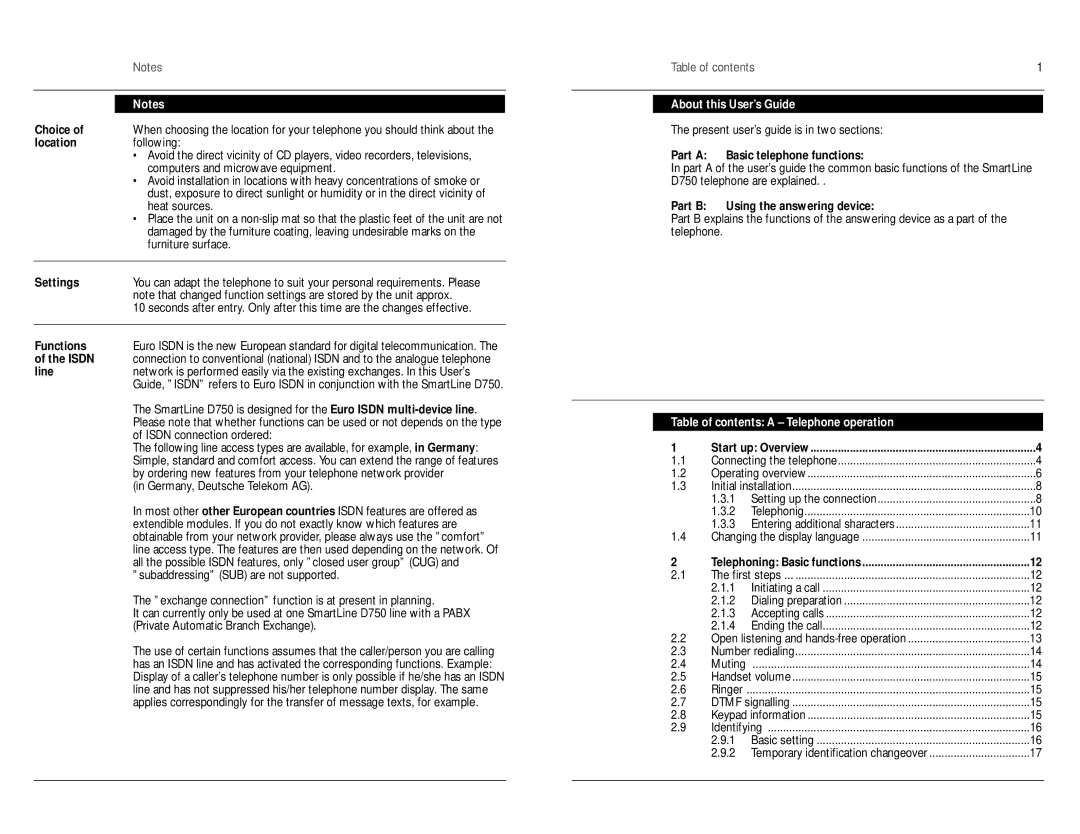
| Notes |
|
|
|
|
| Notes |
Choice of | When choosing the location for your telephone you should think about the |
location | following: |
| • Avoid the direct vicinity of CD players, video recorders, televisions, |
| computers and microwave equipment. |
| • Avoid installation in locations with heavy concentrations of smoke or |
| dust, exposure to direct sunlight or humidity or in the direct vicinity of |
| heat sources. |
| • Place the unit on a |
| damaged by the furniture coating, leaving undesirable marks on the |
| furniture surface. |
|
|
Settings | You can adapt the telephone to suit your personal requirements. Please |
| note that changed function settings are stored by the unit approx. |
| 10 seconds after entry. Only after this time are the changes effective. |
|
|
Functions | Euro ISDN is the new European standard for digital telecommunication. The |
of the ISDN | connection to conventional (national) ISDN and to the analogue telephone |
line | network is performed easily via the existing exchanges. In this User’s |
| Guide, ”ISDN” refers to Euro ISDN in conjunction with the SmartLine D750. |
| The SmartLine D750 is designed for the Euro ISDN |
| Please note that whether functions can be used or not depends on the type |
| of ISDN connection ordered: |
| The following line access types are available, for example, in Germany: |
| Simple, standard and comfort access. You can extend the range of features |
| by ordering new features from your telephone network provider |
| (in Germany, Deutsche Telekom AG). |
| In most other other European countries ISDN features are offered as |
| extendible modules. If you do not exactly know which features are |
| obtainable from your network provider, please always use the ”comfort” |
| line access type. The features are then used depending on the network. Of |
| all the possible ISDN features, only ”closed user group” (CUG) and |
| ”subaddressing” (SUB) are not supported. |
| The ”exchange connection” function is at present in planning. |
| It can currently only be used at one SmartLine D750 line with a PABX |
| (Private Automatic Branch Exchange). |
| The use of certain functions assumes that the caller/person you are calling |
| has an ISDN line and has activated the corresponding functions. Example: |
| Display of a caller’s telephone number is only possible if he/she has an ISDN |
| line and has not suppressed his/her telephone number display. The same |
| applies correspondingly for the transfer of message texts, for example. |
Table of contents | 1 |
About this User’s Guide
The present user’s guide is in two sections:
Part A: Basic telephone functions:
In part A of the user’s guide the common basic functions of the SmartLine D750 telephone are explained. .
Part B: Using the answering device:
Part B explains the functions of the answering device as a part of the telephone.
Table of contents: A – Telephone operation |
| ||
1 | Start up: Overview | 4 | |
1.1 | Connecting the telephone | 4 | |
1.2 | Operating overview | 6 | |
1.3 | Initial installation | 8 | |
| 1.3.1 Setting up the connection | 8 | |
| 1.3.2 | Telephonig | 10 |
| 1.3.3 | Entering additional sharacters | 11 |
1.4 | Changing the display language | 11 | |
2 | Telephoning: Basic functions | 12 | |
2.1 | The first steps | 12 | |
| 2.1.1 | Initiating a call | 12 |
| 2.1.2 | Dialing preparation | 12 |
| 2.1.3 | Accepting calls | 12 |
| 2.1.4 | Ending the call | 12 |
2.2 | Open listening and | 13 | |
2.3 | Number redialing | 14 | |
2.4 | Muting | ........................................................................................... | 14 |
2.5 | Handset volume | 15 | |
2.6 | Ringer | ............................................................................................. | 15 |
2.7 | DTMF signalling | 15 | |
2.8 | Keypad information | 15 | |
2.9 | Identifying | 16 | |
| 2.9.1 | Basic setting | 16 |
| 2.9.2 | Temporary identification changeover | 17 |
|
|
|
|
